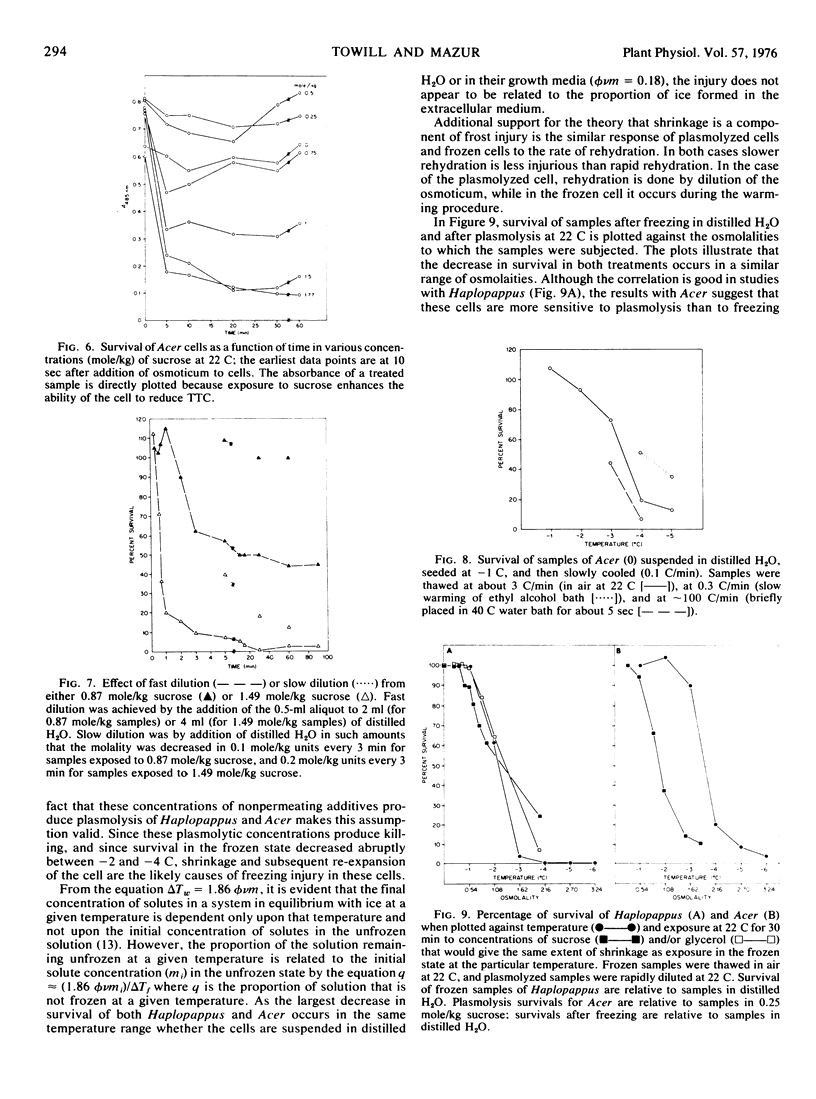Abstract
Haplopappus gracilis and Acer saccharum tissue culture cells are extremely sensitive to freezing injury, and exhibit a decrease in survival from 98% at −1 C to 4% at −3 C (Haplopappus) and 92% at −3 C to 13% at −5 C (Acer) when suspended in distilled H2O, seeded at −1 C, and then cooled by 0.1 C/minute. Similar results are obtained when cells are suspended in growth medium. The extent of shrinkage of cells during freezing can be duplicated by exposure of the cells to plasmolyzing solutions of nonpenetrating substances (Δ Tf = 1.86 φvm). Solutions of sucrose and glycerol that produce extensive plasmolysis cause a decrease in survival within 3 to 5 minutes at room temperature, and the higher the molality to which the cell is exposed the greater the injury. Also, the rate of rehydration of the plasmolyzed cell and of the frozen cell affects its survival, with the slower rate being more beneficial. The close correlation between the decrease in survival at subzero temperatures and the decrease in survival when cells are placed in solutions having osmolalities, which could produce the same extent of shrinkage as these killing temperatures, suggests that this shrinkage is related to freezing injury in tissue culture cells.
Full text
PDF






Selected References
These references are in PubMed. This may not be the complete list of references from this article.
- Greenway H. Effects of slowly permeating osmotica on metabolism of vacuolated and nonvacuolated tissues. Plant Physiol. 1970 Aug;46(2):254–258. doi: 10.1104/pp.46.2.254. [DOI] [PMC free article] [PubMed] [Google Scholar]
- Greenway H., Leahy M. Effects of rapidly and slowly permeating osmotica on metabolism. Plant Physiol. 1970 Aug;46(2):259–262. doi: 10.1104/pp.46.2.259. [DOI] [PMC free article] [PubMed] [Google Scholar]
- Leibo S. P., Farrant J., Mazur P., Hanna M. G., Jr, Smith L. H. Effects of freezing on marrow stem cell suspensions: interactions of cooling and warming rates in the presence of PVP, sucrose, or glycerol. Cryobiology. 1970 Jan-Feb;6(4):315–332. doi: 10.1016/s0011-2240(70)80086-4. [DOI] [PubMed] [Google Scholar]
- Mazur P. Cryobiology: the freezing of biological systems. Science. 1970 May 22;168(3934):939–949. doi: 10.1126/science.168.3934.939. [DOI] [PubMed] [Google Scholar]
- Mazur P., Leibo S. P., Chu E. H. A two-factor hypothesis of freezing injury. Evidence from Chinese hamster tissue-culture cells. Exp Cell Res. 1972;71(2):345–355. doi: 10.1016/0014-4827(72)90303-5. [DOI] [PubMed] [Google Scholar]
- Mazur P., Leibo S. P., Miller R. H. Permeability of the bovine red cell to glycerol in hyperosmotic solutions at various temperatures. J Membr Biol. 1974;15(2):107–136. doi: 10.1007/BF01870084. [DOI] [PubMed] [Google Scholar]
- Olien C. R. Thermodynamic components of freezing stress. J Theor Biol. 1973 Apr;39(1):201–210. doi: 10.1016/0022-5193(73)90217-8. [DOI] [PubMed] [Google Scholar]
- Sakai A. Survival of Plant Tissue at Super-Low Temperature III. Relation between Effective Prefreezing Temperatures and the Degree of Front Hardiness. Plant Physiol. 1965 Sep;40(5):882–887. doi: 10.1104/pp.40.5.882. [DOI] [PMC free article] [PubMed] [Google Scholar]
- Scarth G. W., Levitt J. THE FROST-HARDENING MECHANISM OF PLANT CELLS. Plant Physiol. 1937 Jan;12(1):51–78. doi: 10.1104/pp.12.1.51. [DOI] [PMC free article] [PubMed] [Google Scholar]
- Siminovitch D., Briggs D. R. Studies on the Chemistry of the Living Bark of the Black Locust in Relation to Its Frost Hardiness. III. The Validity of Plasmolysis and Desiccation Tests for Determining the Frost Hardiness of Bark Tissue. Plant Physiol. 1953 Jan;28(1):15–34. doi: 10.1104/pp.28.1.15. [DOI] [PMC free article] [PubMed] [Google Scholar]
- Weiser C. J. Cold Resistance and Injury in Woody Plants: Knowledge of hardy plant adaptations to freezing stress may help us to reduce winter damage. Science. 1970 Sep 25;169(3952):1269–1278. doi: 10.1126/science.169.3952.1269. [DOI] [PubMed] [Google Scholar]


